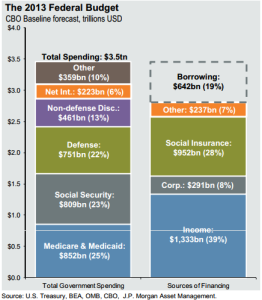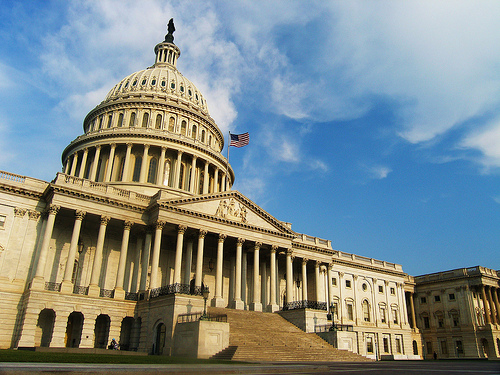“No Man’s life, liberty, or property are safe while the legislature is in session” -Mark Twain
Over the past week, Neil and I have received many questions about the government shutdown and impending debt ceiling and how they might affect the markets. So we thought we would share with you a quick summary of what we believe is happening and how we are positioning our portfolios as a result.
The chart below shows why we are where we are today; it’s simple really: we are spending more than we are taking in, and we have been doing this for quite some time. For 2013, it is projected that almost 20% of government spending will have to be financed. While down from where it had been it still poses a long term fiscal problem.

Ignoring reality, Congress has consistently refused to tackle the task of figuring out just how to bridge the gap between revenue and spending. Political feuding has reached a point that a seemingly simple task, something we do in our households on a monthly basis, has become so arduous, that the government has been in “partial” shut down since October 1. While the shutdown’s affects have been minimal for most Americans – the real problem comes at the end of the month when our debt payments are due. If at that point the government has not reopened and the debt ceiling increased, then we will not have enough money to pay our bond interest and we will be in default. While the effects of this could be catastrophic, most experts feel that this is a very unlikely scenario, and that at some point a deal will be struck. Most likely this will not happen until each congressman feels that his sound bite has been aired enough to assure his re-election. Seemingly, the worst thing that will come out of this will be a period of uncertainty manufactured out of fear and anxiety about the stability of the markets and a continuing mistrust of our government.
Uncertainty is nothing new. Since the congressional budgeting process was established in 1976, Congress has failed to pass a budget 17 times. In 1981 for the first time, failure to pass a budget resulted in a partial government shutdown. Looking at how the S&P 500 fared during past shutdowns suggests that most of the pain happens in and around the period of uncertainty, but once the dust settles, markets get right back to where they left off. (Source: BofAML, US Equity & Quant Strategy, Washington Post, Bloomberg, S&P). The reality is that both the bond and stock market are pretty quick to brush these things off once the initial shock wears off.
While this shutdown itself may not cause any real lasting problems for the markets, it does underscore the fact that our government has become much too involved in market performance. Federal policies are weighing heavily on consumer confidence right now as uncertainty pervades the markets. While these dips may shake the confidence of many investors, we at Canal Capital Management still adhere to a long term perspective and regard these dips as an opportunity to retool our portfolios and buy while others are fearful and prices are depressed..



